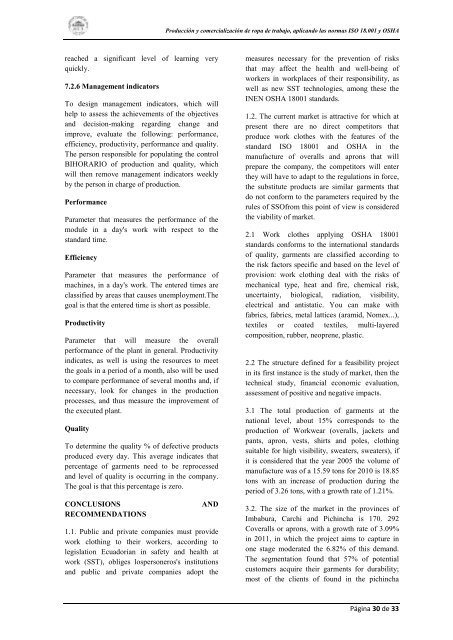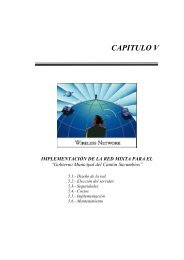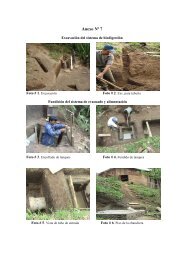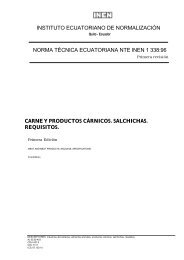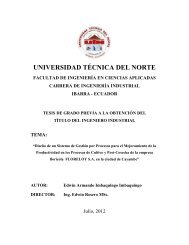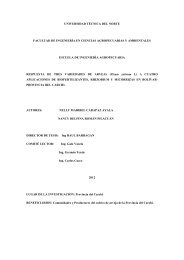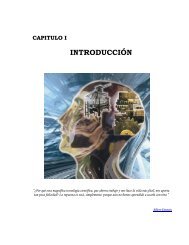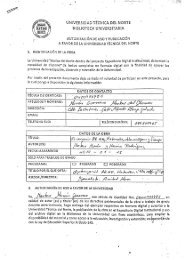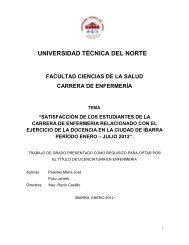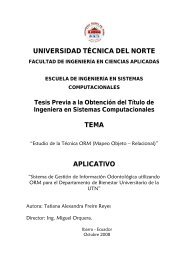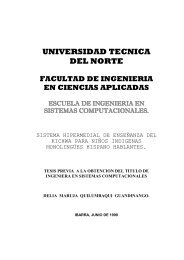04 IT 118-ARTICULO CIENTIFICO Ropa de Trabajo OSHA 18001.pdf
04 IT 118-ARTICULO CIENTIFICO Ropa de Trabajo OSHA 18001.pdf
04 IT 118-ARTICULO CIENTIFICO Ropa de Trabajo OSHA 18001.pdf
You also want an ePaper? Increase the reach of your titles
YUMPU automatically turns print PDFs into web optimized ePapers that Google loves.
Producción y comercialización <strong>de</strong> ropa <strong>de</strong> trabajo, aplicando las normas ISO 18.001 y <strong>OSHA</strong><br />
reached a significant level of<br />
quickly.<br />
7.2.6 Management indicators<br />
learning very<br />
To <strong>de</strong>sign management indicators, which will<br />
help to assess the achievements of the objectives<br />
and <strong>de</strong>cision-making regarding change and<br />
improve, evaluate the following: performance,<br />
efficiency, productivity, performance and quality.<br />
The person responsible for populating the control<br />
BIHORARIO of production and quality, which<br />
will then remove management indicators weekly<br />
by the person in charge of production.<br />
Performance<br />
Parameter that measures the performance of the<br />
module in a day's work with respect to the<br />
standard time.<br />
Efficiency<br />
Parameter that measures the performance of<br />
machines, in a day's work. The entered times are<br />
classified by areas that causes unemployment.The<br />
goal is that the entered time is short as possible.<br />
Productivity<br />
Parameter that will measure the overall<br />
performance of the plant in general. Productivity<br />
indicates, as well is using the resources to meet<br />
the goals in a period of a month, also will be used<br />
to compare performance of several months and, if<br />
necessary, look for changes in the production<br />
processes, and thus measure the improvement of<br />
the executed plant.<br />
Quality<br />
To <strong>de</strong>termine the quality % of <strong>de</strong>fective products<br />
produced every day. This average indicates that<br />
percentage of garments need to be reprocessed<br />
and level of quality is occurring in the company.<br />
The goal is that this percentage is zero.<br />
CONCLUSIONS<br />
RECOMMENDATIONS<br />
AND<br />
1.1. Public and private companies must provi<strong>de</strong><br />
work clothing to their workers, according to<br />
legislation Ecuadorian in safety and health at<br />
work (SST), obliges lospersoneros's institutions<br />
and public and private companies adopt the<br />
measures necessary for the prevention of risks<br />
that may affect the health and well-being of<br />
workers in workplaces of their responsibility, as<br />
well as new SST technologies, among these the<br />
INEN <strong>OSHA</strong> 18001 standards.<br />
1.2. The current market is attractive for which at<br />
present there are no direct competitors that<br />
produce work clothes with the features of the<br />
standard ISO 18001 and <strong>OSHA</strong> in the<br />
manufacture of overalls and aprons that will<br />
prepare the company, the competitors will enter<br />
they will have to adapt to the regulations in force,<br />
the substitute products are similar garments that<br />
do not conform to the parameters required by the<br />
rules of SSOfrom this point of view is consi<strong>de</strong>red<br />
the viability of market.<br />
2.1 Work clothes applying <strong>OSHA</strong> 18001<br />
standards conforms to the international standards<br />
of quality, garments are classified according to<br />
the risk factors specific and based on the level of<br />
provision: work clothing <strong>de</strong>al with the risks of<br />
mechanical type, heat and fire, chemical risk,<br />
uncertainty, biological, radiation, visibility,<br />
electrical and antistatic. You can make with<br />
fabrics, fabrics, metal lattices (aramid, Nomex...),<br />
textiles or coated textiles, multi-layered<br />
composition, rubber, neoprene, plastic.<br />
2.2 The structure <strong>de</strong>fined for a feasibility project<br />
in its first instance is the study of market, then the<br />
technical study, financial economic evaluation,<br />
assessment of positive and negative impacts.<br />
3.1 The total production of garments at the<br />
national level, about 15% corresponds to the<br />
production of Workwear (overalls, jackets and<br />
pants, apron, vests, shirts and poles, clothing<br />
suitable for high visibility, sweaters, sweaters), if<br />
it is consi<strong>de</strong>red that the year 2005 the volume of<br />
manufacture was of a 15.59 tons for 2010 is 18.85<br />
tons with an increase of production during the<br />
period of 3.26 tons, with a growth rate of 1.21%.<br />
3.2. The size of the market in the provinces of<br />
Imbabura, Carchi and Pichincha is 170. 292<br />
Coveralls or aprons, with a growth rate of 3.09%<br />
in 2011, in which the project aims to capture in<br />
one stage mo<strong>de</strong>rated the 6.82% of this <strong>de</strong>mand.<br />
The segmentation found that 57% of potential<br />
customers acquire their garments for durability;<br />
most of the clients of found in the pichincha<br />
Página 30 <strong>de</strong> 33


